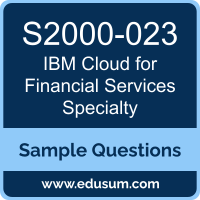01. Which two are key dimensions of IBM's compliance framework?
a) Define
b) Implement
c) Digest
d) Secure
e) Governance
02. How are compliance requirements supported in a hybrid cloud model when utilizing IBM Cloud for Financial Services?
a) Compliance is not achievable in a hybrid cloud
b) By isolating compliance measures to on-premises infrastructure only
c) By having consistent compliance measures across on-premises and cloud environments
d) Compliance is solely the responsibility of the cloud provider
03. Which IBM Cloud platform service should be used as a secure key repository for distributing and orchestrating client encryption keys across multiple clouds?
a) Hyper Protect Crypto Services with Unified Key Orchestrator
b) Quantum Safe TLS with Key Protect
c) Security and Compliance Center Workload Protection
d) Cloud Pak for Security
04. What compliance framework was developed by the American Institute of CPAs (AICPA) as a cybersecurity risk management reporting framework to assist organizations communicate relevant and useful information about the effectiveness of their cybersecurity risk management programs?
a) California Consumer Privacy Act (CCPA)
b) Sarbanes-Oxley Act (SOX)
c) OCC/ Dodd Frank
d) SOC/ Cybersecurity
05. In the context of the IBM Cloud OnePipeline framework, which pipeline is used to ensure applications, deployed artifacts, and source repositories are secure and follow best practices defined by the organization?
a) Continuous Compliance (CC)
b) Continuous Integration (CI)
c) Continuous Development (CD)
d) Continuous Delivery Foundation (CDF)
06. What option is available in IBM Cloud Enterprise account billing?
a) Enterprise Flexible Account
b) Consolidated Billing
c) Account Groups
d) Subscription Management
07. Which two ways does IBM Cloud for Financial Services help clients modernize and transform businesses faster?
a) By addressing regulatory compliance across internal and digital supply chain data and workloads
b) By limiting performance insights
c) By securing development and management of containerized and cloud-native applications
d) By classifying and monitoring integrity and protection
e) With reactive issue resolution
08. What IT infrastructure integration challenges are faced by the Banking and Insurance industry when adopting cloud solutions?
a) Integration is not necessary for cloud adoption
b) Seamless integration of cloud solutions with legacy systems
c) Determines which markets apply to which workoads
d) Integration is only relevant for non-cloud solutions
09. In the IBM Cloud for Financial Services reference architecture, when considering the appropriate workload view for the enterprise in a hybrid cloud environment, what are the implications of adopting a fully distributed approach for monitoring workloads separately on each cloud platform?
a) Centralized monitoring with a single control plane in on-premises data centers
b) Exporting monitoring data from the cloud platform without associated costs
c) Loss of a centralized view of workloads in a hybrid cloud architecture
d) Reduced network bandwidth requirements
10. What features are deployed in a secure landing zone in IBM Cloud for Financial Services?
a) Create backup policies in the management VPCs
b) Object storage instances for flow logs and an activity tracker
c) Creation of an IBM Event Streams instance
d) Automatic disaster recovery site
 The purpose of this Sample Question Set is to provide you with information about the IBM Cloud for Financial Services v2 Specialty exam. These sample questions will make you very familiar with both the type and the difficulty level of the questions on the S2000-023 certification test. To get familiar with real exam environment, we suggest you try our Sample IBM Cloud for Financial Services Specialty Certification Practice Exam. This sample practice exam gives you the feeling of reality and is a clue to the questions asked in the actual IBM Cloud for Financial Services v2 Specialty certification exam.
The purpose of this Sample Question Set is to provide you with information about the IBM Cloud for Financial Services v2 Specialty exam. These sample questions will make you very familiar with both the type and the difficulty level of the questions on the S2000-023 certification test. To get familiar with real exam environment, we suggest you try our Sample IBM Cloud for Financial Services Specialty Certification Practice Exam. This sample practice exam gives you the feeling of reality and is a clue to the questions asked in the actual IBM Cloud for Financial Services v2 Specialty certification exam.